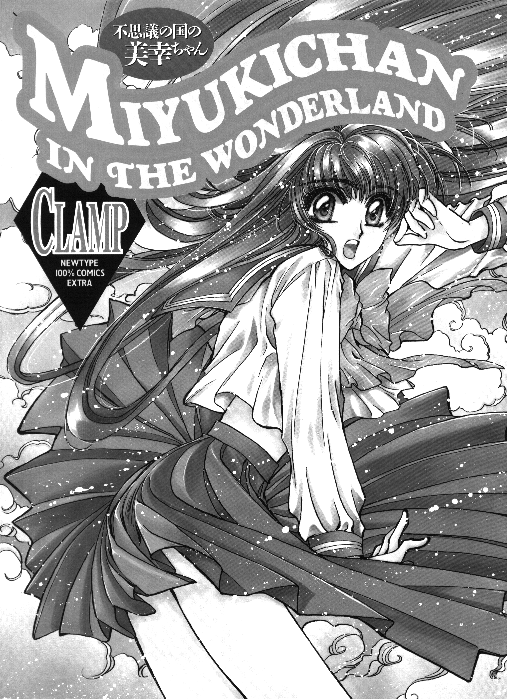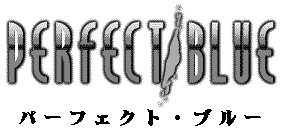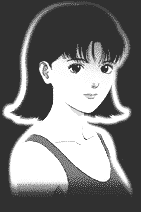AnimeXTRA
1997 was a dreadful year for Japanese animation in Britain, the majority of titles released were hard to imagine anyone over 12 (age or IQ) buying. Going by the reviews on the previous pages, you’d be forgiven for thinking all the ‘good stuff’ has come out. But the problem is less the lack of decent anime, more the narrow market to which it is targetted here. Back in TC14/15, there was a list of seven excellent, unreleased titles: with the sole exception of Sol Bianca, they all remain that way four years later. So let’s take a look at a selection, available on import or through other fan sources, which all ram a tentacle up the orifice of the prevailing, erroneous opinion which says that anime is just for a 16-25, male audience. Ladies and gentlement, please welcome our first contender! At 99 lbs. dripping wet — and she usually is…

Miyuki-Chan in Wonderland – Er, perhaps prevailing opinion might have a bit of a point here, despite the lack of any male characters. Cross Alice in Wonderland with Barbarella (to which the comic explicitly pays homage) and you’ll be in the right area…sort of. For this little gem crams Wonderland and Through the Looking Glass into thirty minutes, while loading them both with a heady air of sexuality.
In terms of pheromones per minute, it’s world-class stuff; the minimal nudity and lack of any actual sex is simply evidence of the creators’ skills. The main twist is making every character female and more or less sex-crazed i.e. the White Rabbit is now a bunny-girl on a skateboard. Familiarity with the books is thus useful, though at only 15 mins each, plot development is, shall we say, somewhat limited; Wonderland comes off better.
In terms of frilly undergarments per minute, this is also world-class stuff; there’s copious lingerie. However, it’s done with such charm and humour that you can’t possibly be offended, except perhaps by the relentless techno-reggae soundtrack, that will liquefy your brain and keep you humming for weeks. Deal with the inevitable accusations of sexism by revealing that it’s based on a strip by the female artists group known as ‘Clamp’. [God knows what they were on. It probably used lots of batteries…] and it was even a woman who first dragged me to see it (Hi, Christine!). Maybe the creators should label their product “politically-correct smut”, and get Channel 4 to buy it.
Child’s Toy – While most kids’ TV is dreck, every so often, you get a show aimed at a younger audience, that also makes fine entertainment for adults: Tiswas, The Press Gang, Tiny Toon Adventures, and now Child’s Toy, a Japanese show whose target audience would seem to be pre-teen, but whose central characters include an eleven-year old schoolgirl and her pimp.
Yes, pimp. This appears to be how heroine Sana, refers to her manager — she also has a part-time job as a TV actress. And she needs looking after, since her mouth gets her into trouble constantly, notably with the class delinquent, whom we first encounter blackmailing the teachers into permitting his anarchy. Being made for television, the animation isn’t the greatest, but this is made up for by a razor-sharp script that can swing from comedy to pathos in a second without seeming strained or forced. And Sana, too, is both wise beyond her years and terminally dumb; Clueless, starring a hyperactive version of Wednesday Addams. It also benefits from truly great supporting characters: the mother, as unflappable as Sana is manic, with a squirrel living in her hair; the delinquent, not quite what he seems; and a bizarre bat/rabbit narrator that crops up sporadically.
This amphetamine-crazed remake – the original video told the story rather less energetically – resembles Dragon Half, with a willingness to throw the rule-book away and fly blind. Putting it in conventional terms, Heathers meets Saviour of the Soul is as close as I can get, for it blends the mundane and the fantastic with a pithy wit which blows away anything on British TV.
Here is Greenwood – A traditional staple of Japanese animation is the high-school comedy, in which a spectrum of kooky characters interact with humourous results. This is seen frequently, even in shows aimed at adults: it may be that in a strictly ordered and disciplined society like Japan, school is one of the few places where a (very) little individuality is tolerated. Hence shows like Urusei Yatsura have an appeal far beyond the contemporaries of the teenage characters.
Thus we have Greenwood, whose title springs from Robin Hood – a place where outlaws hang out. In the show, it’s the name of a school dorm which acts as a dumping ground for religious nuts, guys who act like girls, and hero Kazuya Hasukawa, in love with his brother’s wife. The whole show is low-key, lacking the manic chases, fight scenes or slapstick humour seen in other series, relying instead on a berserk solar system of plots and subplots (imagine Jerry Springer shows entitled My Sister is a Psychopath, or A Ghost’s got a Crush on Me), though a lot of its charm is the phlegmatic way in which the characters react even to these bizarre events.
In terms of progression, there doesn’t seem to be a lot, story- or persona-wise, probably an inevitable result of condensing a long running story into a few animated half-hours. Yet this lends it an audacious air: one episode depicts the making of an amateur movie, and the opening credits of the film become the closing credits of the show. The end result is a show that’s charming and lightweight, without ever evaporating completely.
Sailor Stars – Finally, a brief nod of unexpected appreciation to this version of infamous teen-girl merchandising machine, Sailor Moon. While still engaging in a relentless recycling of animation, it has…well, a Gothic horror feel which certainly came as a shock. In the first six episodes, the multiple heroines (tall! short! blonde! brunette! one for every taste! collect the whole set!) have to face villainess Neherenia, whom they previously sealed into another dimension. She’s great – think Cruella DeVille with a hangover – and for two hours, kicks Sailor arse. Sadly, part VI lets the side down with an (admittedly, entirely expected) “love conquers all” ending, but until then, it’s far better than I’d have predicted, assisted by a good score. Chances of this grimly fiendish series ever appearing on British television? Well, do you see this snowball, and this inferno-like region..?
So, despite the gloom and doom of the opening paragraph of this article, there are also signs of hope – maybe not quite a field of daffodils yet, but the odd green shoot. One such title achieved fame after a single late-night screening at a convention, and has since led to it becoming perhaps the most eagerly anticipated title of 1998.

It’s always a delight when something manages to surprise you, or bypass your expectations. Anyone looking at a piece of Japanese animation entitled Perfect Blue might be forgiven for thinking they were going to see something involving barely pubescent girls, demons, and places daylight doesn’t reach. You would, however, be utterly wrong. The first anime giallo owes a lot to the works of Dario Argento, with perhaps a nod to David Cronenberg, as the heroine moves through a lurid world of hallucinations and stylish murders. You wouldn’t guess it from the start, as a trio of idol singers squeak away for all their worth, though one, Mima Kirigoe, has decided to leave the group and try to make a career as an actress. Things soon start to sink into the Twilight Zone, with Mima finding herself the target of obsessive fan, ‘Mimaniac’, who documents her every move on the Internet in disturbing detail, and is clearly not chuffed by her decision to quit singing, as the parcel bomb she gets proves.
Despite this, her first acting job is a stripper in detective series ‘Double Bind’, and she finds herself exposing rather more than she’d like. Neither this nor the nude publicity pics go down well with her stalker, and the writer has his eyes gouged out for his temerity. Mima is by now seriously losing it under the strain: her old self keeps appearing to her in visions, and the reality/fantasy/ dream/nightmare lines become perilously thin. I’ll say no more — not purely out of a desire to avoid spoiling it, but also because I’m still not confident enough to state precisely what the hell is going on; as well as Argento’s visual style, they borrow his plot coherence! [And I think Masahiro Ikumi must have listened to Goblin while writing the score…]

Regardless of this, it’s one hell of a ride. At first glance, there’s no point to Perfect Blue being animated; the style also bears more comparison to a Hitchcock movie than any anime, and the characters lack the excessively over-sized eyes often seen in the medium. It could certainly be said that the film contains little that couldn’t be done in live-action — while technically true, it is hard to envisage how they could have made the hallucinatory sequences which litter the movie, so utterly convincing in any other way. Instead, from half way through (which is only about 40 minutes — this is no bring-yer-own-sandwiches epic), it becomes incredibly easy to lose track of whether anything is going on purely in Mina’s head or in ‘reality’. [If ever those quote marks were justified, it’s here] The movie is based on a novel by Yoshikazu Takeuchi, and even before it opened in Japan, a semi-sequel was already in the pipeline — it will apparently be ‘Double Bind’, the TV show featured in the film.
Like Miyuki-Chan in Wonderland, Perfect Blue’ is animated by Madhouse, and so is typically slick. Director Satoshi Kon wrote part of Katsuhiro Otomo’s latest, Memories (see the Film Festival Blitz) and Otomo himself was an advisor here, which perhaps helps to explain the painstaking effort that has clearly gone into the project. All of these names are a fine pedigree for any piece of anime, and while Perfect Blue is not a ground-breaking pioneer like Akira, it’s adult entertainment in the best sense of the word.
[Perfect Blue is out theatrically in late ’98, with a video release to follow]